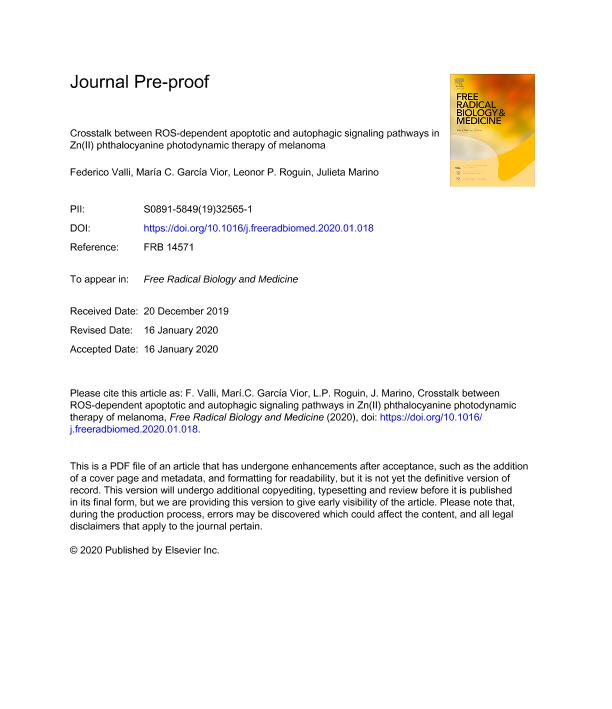Mostrar el registro sencillo del ítem
dc.contributor.author
Valli, Federico

dc.contributor.author
Garcia Vior, María Cecilia

dc.contributor.author
Roguin, Leonor Patricia

dc.contributor.author
Marino, Veronica Julieta

dc.date.available
2020-07-02T15:30:19Z
dc.date.issued
2020-01-01
dc.identifier.citation
Valli, Federico; Garcia Vior, María Cecilia; Roguin, Leonor Patricia; Marino, Veronica Julieta; Crosstalk between ROS-dependent apoptotic and autophagic signaling pathways in Zn(II) phthalocyanine photodynamic therapy of melanoma; Elsevier Science Inc; Free Radical Biology and Medicine; 1-1-2020
dc.identifier.issn
0891-5849
dc.identifier.uri
http://hdl.handle.net/11336/108665
dc.description.abstract
Melanoma is the most aggressive type of skin cancer, highly resistant to conventional therapies. Photodynamic therapy (PDT) is a minimally invasive treatment modality that combines the use of a photosensitizer, visible light and molecular oxygen, leading to ROS generation in the specific site of irradiation. The cationic zinc(II) phthalocyanine Pc13 has shown to be a potent photosensitizer in different melanoma cell lines. In this study, we explored the intracellular signaling pathways triggered by Pc13 PDT and the role of these cascades in the phototoxic action of Pc13 in human melanoma A375 cells. ROS-dependent activation of MAPKs p38, ERK, JNK and PI3K-I/AKT was observed after treatment. Inhibition of p38 reduced Pc13 phototoxicity, whereas blockage of ERK did not affect this response. Conversely, JNK inhibition potentiated the effect of Pc13 PDT. Results obtained indicate that p38 is involved in the cleavage of PARP-1, an important mediator of apoptosis. On the other hand, Pc13 irradiation induced the activation of an autophagic program, as evidenced by enhanced levels of Beclin-1, LC3-II and GFP-LC3 punctate staining. We also demonstrated that this autophagic response is promoted by JNK and negatively regulated by PI3K-I/AKT pathway. The blockage of autophagy increased Pc13 phototoxicity and enhanced PARP-1 cleavage, revealing a protective role of this mechanism, which tends to prevent apoptotic cell death.Furthermore, reduced susceptibility to treatment and increased activation of autophagy were detected in A375 cells submitted to repeated cycles of Pc13 PDT, indicating that autophagy could represent a mechanism of resistance to PDT. The efficacy of Pc13 PDT and an improved phototoxic action in combination with chloroquine were also demonstrated in tumor spheroids. In conclusion, we showed the interplay between apoptotic and autophagic signaling pathways triggered by Pc13 PDT-induced oxidative stress. Thus, autophagy modulation represents a promising therapeutic strategy to potentiate the efficacy of PDT in melanoma.
dc.format
application/pdf
dc.language.iso
eng
dc.publisher
Elsevier Science Inc

dc.rights
info:eu-repo/semantics/openAccess
dc.rights.uri
https://creativecommons.org/licenses/by-nc-sa/2.5/ar/
dc.subject
CELL SIGNALING
dc.subject
AUTOPHAGY
dc.subject
APOPTOSIS
dc.subject
PHOTODYNAMIC THERAPY
dc.subject
MELANOMA
dc.subject.classification
Bioquímica y Biología Molecular

dc.subject.classification
Ciencias Biológicas

dc.subject.classification
CIENCIAS NATURALES Y EXACTAS

dc.title
Crosstalk between ROS-dependent apoptotic and autophagic signaling pathways in Zn(II) phthalocyanine photodynamic therapy of melanoma
dc.type
info:eu-repo/semantics/article
dc.type
info:ar-repo/semantics/artículo
dc.type
info:eu-repo/semantics/publishedVersion
dc.date.updated
2020-07-01T17:10:56Z
dc.journal.pais
Estados Unidos

dc.journal.ciudad
Amsterdam
dc.description.fil
Fil: Valli, Federico. Consejo Nacional de Investigaciones Científicas y Técnicas. Oficina de Coordinación Administrativa Houssay. Instituto de Química y Físico-Química Biológicas "Prof. Alejandro C. Paladini". Universidad de Buenos Aires. Facultad de Farmacia y Bioquímica. Instituto de Química y Físico-Química Biológicas; Argentina
dc.description.fil
Fil: Garcia Vior, María Cecilia. Universidad de Buenos Aires. Facultad de Farmacia y Bioquímica. Departamento de Química Orgánica; Argentina. Consejo Nacional de Investigaciones Científicas y Técnicas; Argentina
dc.description.fil
Fil: Roguin, Leonor Patricia. Consejo Nacional de Investigaciones Científicas y Técnicas. Oficina de Coordinación Administrativa Houssay. Instituto de Química y Físico-Química Biológicas "Prof. Alejandro C. Paladini". Universidad de Buenos Aires. Facultad de Farmacia y Bioquímica. Instituto de Química y Físico-Química Biológicas; Argentina
dc.description.fil
Fil: Marino, Veronica Julieta. Consejo Nacional de Investigaciones Científicas y Técnicas. Oficina de Coordinación Administrativa Houssay. Instituto de Química y Físico-Química Biológicas "Prof. Alejandro C. Paladini". Universidad de Buenos Aires. Facultad de Farmacia y Bioquímica. Instituto de Química y Físico-Química Biológicas; Argentina
dc.journal.title
Free Radical Biology and Medicine

dc.relation.alternativeid
info:eu-repo/semantics/altIdentifier/url/https://linkinghub.elsevier.com/retrieve/pii/S0891584919325651
dc.relation.alternativeid
info:eu-repo/semantics/altIdentifier/doi/http://dx.doi.org/10.1016/j.freeradbiomed.2020.01.018
Archivos asociados
